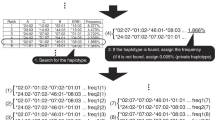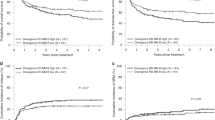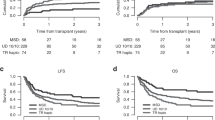Abstract
A human leukocyte antigen (HLA)-matched unrelated donor is the primary alternative donor for allogeneic hematopoietic cell transplantation in Japan. In considering an optimal donor registry size, the availability of HLA-matched donors is important. In this study, the probability of finding an HLA-A, -B, -C, and -DRB1 allele-matched donor was estimated using two different methods based on the haplotype frequencies in the Japanese population: an actual measurement method (AMM) and a formula method (FM). According to AMM, the probabilities of finding an HLA-matched donor were 40.5% in 100,000 donors, 54.4% in 300,000, 60.0% in 500,000, and 63.4% in 700,000. On the other hand, according to FM, the probabilities were 47.8% in 100,000 donors, 59.9% in 300,000, 65.3% in 500,000, and 68.8% in 700,000. The probabilities increased by 8.6 or 7.7%, 3.2 or 3.1%, 2.1 or 1.9%, and 1.6 or 1.3% in AMM or FM, respectively, as the registry size increased by 100,000. The rate of increase in the probability of finding an HLA-matched donor will become smaller as the registry size increases due to the diversity of haplotypes. Therefore, it is important to set a target donor registry size for efficient donor recruitment by considering the haplotype frequencies in the population.
This is a preview of subscription content, access via your institution
Access options
Subscribe to this journal
Receive 12 print issues and online access
$259.00 per year
only $21.58 per issue
Buy this article
- Purchase on SpringerLink
- Instant access to full article PDF
Prices may be subject to local taxes which are calculated during checkout

Similar content being viewed by others
References
Morishima Y, Sasazuki T, Inoko H, Juji T, Akaza T, Yamamoto K, et al. The clinical significance of human leukocyte antigen (HLA) allele compatibility in patients receiving a marrow transplant from serologically HLA-A, HLA-B, and HLA-DR matched unrelated donors. Blood. 2002;99:4200–6.
Morishima Y, Yabe T, Matsuo K, Kashiwase K, Inoko H, Saji H, et al. Effects of HLA allele and killer immunoglobulin-like receptor ligand matching on clinical outcome in leukemia patients undergoing transplantation with T-cell-replete marrow from an unrelated donor. Biol Blood Marrow Transplant. 2007;13:315–28.
Kawase T, Morishima Y, Matsuo K, Kashiwase K, Inoko H, Saji H, et al. High-risk HLA allele mismatch combinations responsible for severe acute graft-versus-host disease and implication for its molecular mechanism. Blood. 2007;110:2235–41.
Kanda Y, Chiba S, Hirai H, Sakamaki H, Iseki T, Kodera Y, et al. Allogeneic hematopoietic stem cell transplantation from family members other than HLA-identical siblings over the last decade (1991-2000). Blood. 2003;102:1541–7.
Atsuta Y, Suzuki R, Nagamura-Inoue T, Taniguchi S, Takahashi S, Kai S, et al. Disease-specific analyses of unrelated cord blood transplantation compared with unrelated bone marrow transplantation in adult patients with acute leukemia. Blood. 2009;113:1631–8.
Atsuta Y, Morishima Y, Suzuki R, Nagamura-Inoue T, Taniguchi S, Takahashi S, et al. Comparison of unrelated cord blood transplantation and HLA-mismatched unrelated bone marrow transplantation for adults with leukemia. Biol Blood Marrow Transplant. 2012;18:780–7.
Kanda J, Saji H, Fukuda T, Kobayashi T, Miyamura K, Eto T, et al. Related transplantation with HLA-1 Ag mismatch in the GVH direction and HLA-8/8 allele-matched unrelated transplantation: a nationwide retrospective study. Blood. 2012;119:2409–16.
Kanda J, Ichinohe T, Kato S, Uchida N, Terakura S, Fukuda T, et al. Unrelated cord blood transplantation vs related transplantation with HLA 1-antigen mismatch in the graft-versus-host direction. Leukemia. 2013;27:286–94.
Kanda J, Long GD, Gasparetto C, Horwitz ME, Sullivan KM, Chute JP, et al. Reduced-intensity allogeneic transplantation using alemtuzumab from HLA-matched related, unrelated, or haploidentical related donors for patients with hematologic malignancies. Biol Blood Marrow Transplant. 2014;20:257–63.
Schmidt AH, Sauter J, Pingel J, Ehninger G. Toward an optimal global stem cell donor recruitment strategy. PLoS ONE. 2014;9:e86605.
Kwok J, Guo M, Yang W, Ip P, Chan GCF, Ho J, et al. Estimation of optimal donor number in Bone Marrow Donor Registry: Hong Kong’s experience. Hum Immunol. 2017;78:610–3.
Ikeda N, Kojima H, Nishikawa M, Hayashi K, Futagami T, Tsujino T, et al. Determination of HLA-A, -C, -B, -DRB1 allele and haplotype frequency in Japanese population based on family study. Tissue Antigens. 2015;85:252–9.
Gonzalez-Galarza FF, Christmas S, Middleton D, Jones AR. Allele frequency net: a database and online repository for immune gene frequencies in worldwide populations. Nucleic Acids Res. 2011;39:D913–9.
Spellman SR, Eapen M, Logan BR, Mueller C, Rubinstein P, Setterholm MI, et al. A perspective on the selection of unrelated donors and cord blood units for transplantation. Blood. 2012;120:259–65.
Kanda J, Ichinohe T, Fuji S, Maeda Y, Ohashi K, Fukuda T, et al. Impact of HLA mismatch direction on the outcome of unrelated bone marrow transplantation: a retrospective analysis from the Japan Society for Hematopoietic Cell Transplantation. Biol Blood Marrow Transplant. 2015;21:305–11.
Terakura S, Atsuta Y, Tsukada N, Kobayashi T, Tanaka M, Kanda J, et al. Comparison of outcomes of 8/8 and 7/8 allele-matched unrelated bone marrow transplantation and single-unit cord blood transplantation in adults with acute leukemia. Biol Blood Marrow Transplant. 2016;22:330–8.
Kollman C, Abella E, Baitty RL, Beatty PG, Chakraborty R, Christiansen CL, et al. Assessment of optimal size and composition of the U.S. National Registry of hematopoietic stem cell donors. Transplantation. 2004;78:89–95.
Gragert L, Eapen M, Williams E, Freeman J, Spellman S, Baitty R, et al. HLA match likelihoods for hematopoietic stem-cell grafts in the U.S. registry. N Engl J Med. 2014;371:339–48.
Pidala J, Kim J, Schell M, Lee SJ, Hillgruber R, Nye V, et al. Race/ethnicity affects the probability of finding an HLA-A, -B, -C and -DRB1 allele-matched unrelated donor and likelihood of subsequent transplant utilization. Bone Marrow Transplant. 2013;48:346–50.
Acknowledgements
This study was supported in part by JSPS KAKENHI Grant Number JP17K16186 and the Practical Research Project for Allergic Diseases and Immunology from Japan Agency for Medical Research and Development, AMED (18ek0510014h0003).
Author information
Authors and Affiliations
Corresponding author
Ethics declarations
Conflict of interest
The authors declare that they have no conflict of interest.
Rights and permissions
About this article
Cite this article
Nishiwaki, S., Tanaka, H., Kojima, H. et al. Availability of HLA-allele-matched unrelated donors: estimation from haplotype frequency in the Japanese population. Bone Marrow Transplant 54, 300–303 (2019). https://doi.org/10.1038/s41409-018-0263-9
Received:
Revised:
Accepted:
Published:
Issue date:
DOI: https://doi.org/10.1038/s41409-018-0263-9
This article is cited by
-
A consideration for efficient unrelated hematopoietic stem cell source acquisition—from an experience of Japan
Bone Marrow Transplantation (2020)



